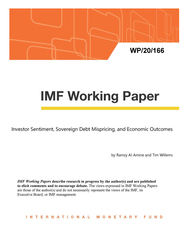
Investor Sentiment, Sovereign Debt Mispricing, and Economic Outcomes
Investor Sentiment, Sovereign Debt Mispricing, and Economic Outcomes
READ MORE...
Volume/Issue:
Volume 2020
Issue 166
Publication date: August 2020
ISBN: 9781513550855
$18.00
Add to Cart by clicking price of the language and format you'd like to purchase
Available Languages and Formats
| English |
Prices in red indicate formats that are not yet available but are forthcoming.
Topics covered in this book
This title contains information about the following subjects.
Click on a subject if you would like to see other titles with the same subjects.
Exports and Imports , Economics- Macroeconomics , Public Finance , WP , sub , cross-validation procedure , sentiment , sovereign debt , sovereign spreads , debt crises , over-optimism , growth forecasting , real GDP growth , credit rating , growth forecast , spread discount , Current account deficits , Government consumption , Southern Europe , leave-one-out procedure , spreads data , investor sentiment
Summary
We find that countries which are able to borrow at spreads that seem low given fundamentals (for example because investors take a bullish view on a country's future), are more likely to develop economic difficulties later on. We obtain this result through a two-stage procedure, where a first regression links sovereign spreads to fundamentals, after which residuals from this regression are deployed in a second stage to assess their impact on future outcomes (real GDP growth and the occurrence of fiscal crises). We confirm the relevance of past sovereign debt mispricing in several out-of-sample exercises, where they reduce the RMSE of real GDP growth forecasts by as much as 15 percent. This provides strong support for theories of sentiment affecting the business cycle. Our findings also suggest that countries shouldn't solely rely on spread levels when determining their fiscal strategy; underlying fundamentals should inform policy as well, since historical relationships between spreads and fundamentals often continue to apply in the medium-to-long run.
Copyright © 2010 - 2024
Powered by:
AIDC



